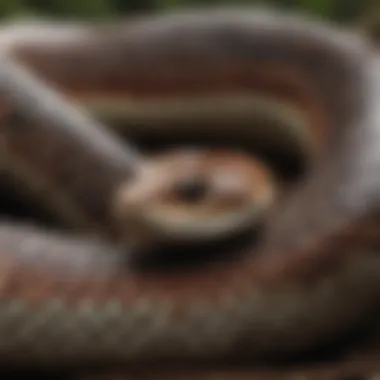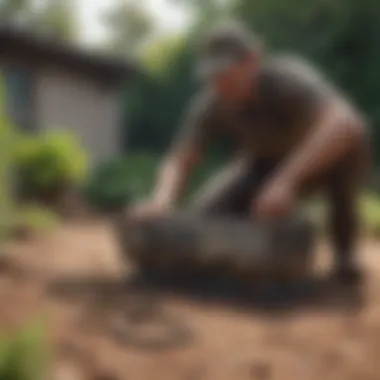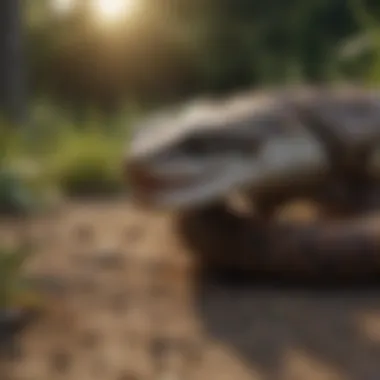How to Effectively Trap a Snake in Your Yard


Intro
Trapping snakes in your yard can be a crucial task, especially if you live in an area where they are common. Understanding the different aspects of snake behavior and their natural habitats can significantly improve your chances of successful trapping. In this article, we will delve into the necessary steps for effectively capturing these reptiles, from species identification to humane capture methods.
Understanding the Pest
Identification
To effectively trap snakes, it is essential first to identify which species are present in your area. Common snakes that might intrude into residential spaces include the garter snake, black rat snake, and in some places, venomous ones like the rattlesnake or copperhead. Identifying the snake can prevent unnecessary panic and help in choosing the right trapping method. You can look for key features such as color, markings, and size.
Life Cycle
Understanding the life cycle of snakes is also important. Snakes typically go through several stages: egg, juvenile, and adult. The juvenile stage is critical since young snakes are more likely to wander into human habitats in search of food or shelter. Knowledge of their reproductive periods can be beneficial, as property infestation may increase during mating seasons, leading to higher visibility.
Pest Prevention Strategies
Preventing snakes from entering your yard is the most effective means of control. Here are some strategies to consider.
Environment Modification
Modifying the environment around your home can significantly reduce the likelihood of attracting snakes. Keep your yard clean and clear of tall grasses, piles of leaves, or debris, as these provide perfect hiding spots. Additionally, consider trimming shrubs and removing other potential hiding spots. Properly managing your garden ensures less food and shelter for snakes.
Physical Barriers
Installing physical barriers can also deter snakes. Consider building barriers such as fences that are at least 3 feet high and buried a few inches underground to prevent burrowing. Use wire mesh with small openings to keep even the smallest snakes at bay. Ensuring that gaps around the home’s foundation are sealed will also minimize access points.
Control Methods
If prevention fails and snakes are present, controlling the situation becomes necessary. There are various control methods to consider, each with its benefits and drawbacks.
Chemical Control
Chemical control generally involves the use of snake repellents. However, it is vital to use these methods judiciously to avoid harming non-target species or causing environmental damage. Read the labels carefully and follow instructions to ensure safety.
Biological Control
Lastly, biological control involves using natural predators to manage snake populations. While this method may not be feasible for everyone, having a pet such as a cat or dog can sometimes deter snakes. Their presence can affect the movement patterns of snakes in the area.
The key to successful trapping lies in understanding snake behavior, habitat, and effective management strategies.
By following these guidelines, you can better navigate the complexities of dealing with snakes in your yard, ensuring both safety and efficacy in the trapping process.
Preface to Snake Trapping
Snake trapping is a critical skill for homeowners who wish to manage their outdoor spaces effectively. Recognizing the necessity of this practice stems from concerns about safety, property integrity, and ecological balance. In urban environments, snakes can find themselves amidst human lifestyles, often leading to conflict. Thus, understanding snake trapping becomes paramount for both personal safety and wildlife conservation.
The Importance of Snake Trapping
Trapping snakes effectively serves multiple purposes. First and foremost, it helps in reducing potential dangers associated with venomous species. While most snakes are harmless, the presence of certain types, such as the Eastern Diamondback Rattlesnake or the Copperhead, requires immediate action. Trapping these snakes decreases the risk of unwanted encounters, which could lead to harmful situations.
Moreover, effective snake trapping allows for responsible wildlife management. Instead of exterminating the creatures, relocating captured snakes is a preferable solution that supports ecological balance. By understanding snake habitats and behavior, homeowners can take proactive steps to discourage snakes from settling in their yards.
Lastly, educating oneself about snake trapping contributes to a greater awareness of the local ecosystem. Homeowners become more attuned to their environment, leading to better practices for maintaining their yards. This awareness fosters a respect for wildlife and enhances community efforts to coexist with nature.
Understanding Snake Behavior


To trap a snake effectively, it is essential to comprehend its behavior. Snakes are generally secretive and tend to avoid human interactions. However, they might enter residential areas in search of food, shelter, or breeding sites. Familiarizing oneself with their habits can increase the success rate of trapping efforts.
Snakes are ectothermic, meaning they rely on external sources to regulate their body temperature. Therefore, they are often found basking in sunny spots or hiding in cooler, shaded areas. Observing these behavioral patterns can aid in identifying the areas where traps should be set.
Additionally, understanding the feeding habits of local snake species is crucial. Most snakes prey on small mammals, birds, or insects. Ensuring that outdoor spaces are free of debris and potential food sources for snakes can discourage them from visiting your yard.
Identifying Snake Species in Your Area
Understanding the various snake species that may inhabit your vicinity is essential for effective snake trapping. Each species can exhibit distinct behaviors, habitats, and levels of danger. By accurately identifying these snakes, you not only increase the chances of a successful trap but also ensure the safety of both the snakes and household members. Recognizing local species helps to tailor trapping methods and select appropriate bait, improving the efficiency of your trapping efforts while minimizing unnecessary harm to the snakes.
Common Snake Species Found in Urban Environments
Urban regions are not devoid of snake life. In many cases, certain species thrive alongside humans, adapting to the environment. The most common snake types often spotted in residential areas include:
- Garter Snake: Typically small and non-venomous, garter snakes are known for their distinctive stripes along the length of their bodies. They often hunt for amphibians and insects, usually preferring moist habitats.
- Black Rat Snake: This non-venomous species can reach considerable lengths. Black rat snakes are known to inhabit structures and are often mistaken for venomous counterparts due to their coloration.
- Eastern Massasauga Rattlesnake: While less common in urban areas, some regions have populations of these rattlesnakes. They are venomous and possess rattles on their tails, serving as a warning to potential threats.
- Copperhead: Found in some suburban areas, copperheads are also venomous. Their distinctive coloration allows them to camouflage well among leaf litter, making them harder to spot.
- Ring-necked Snake: Known for their colorful underbellies, ring-necked snakes are small and typically shy. They reside in moist environments, often seeking shelter beneath rocks or logs.
Red Flags: Signs of a Snake Presence
Being attentive to signs of snake activity can significantly enhance your trapping strategy. Here are several indicators you might encounter:
- Shedding Skin: Snakes periodically shed their skins as they grow. The found skin is a strong indication of snake activity in your yard.
- Feces: Snake droppings often resemble raccoon feces but may contain fur, bones, or shell remnants of their prey, providing a telltale sign of their presence.
- Tracks: When the ground is muddy or soft, observing tracks can be helpful. The trails they leave may appear as straight lines or slight indentations in the earth.
- Gaps and Holes: Snakes often seek refuge in small openings. Inspecting gaps in foundations, gardening beds, or attics may reveal potential hiding spots for snakes.
- Unusual Noises: Sometimes, the presence of snakes is detected by unusual sounds, such as rustling leaves or movements in bushy areas.
Preparation for Snake Trapping
Preparation for trapping snakes is a vital stage in the overall process. Adequate preparation leads to more successful trapping outcomes and decreased risk for both the homeowner and the snakes. Being well-prepared means knowing your environment, the type of snakes in your area, and having the right tools at your disposal. This phase sets the stage for efficient trapping while promoting humane practices.
Assessing Your Yard for Snake Activity
Before setting traps, surveying your yard for signs of snake activity is essential. Look for any cover that may provide shelter, such as tall grass, piles of debris, or dense bushes. Additionally, observe for potential food sources like rodents or insects. Snakes are less selective and will choose habitats that support their basic needs.
During your assessment, consider the following signs:
- Shedding Skin: Indicates recent snake presence. Look for translucent scales, often found near hiding spots.
- Tracks or Trails: Note any disturbances in the soil or areas where grass patterns appear flattened.
- Droppings: The presence of feces can be a tell-tale sign. Examining these droppings can give you clues on the snake’s diet.
Understanding the layout of your yard will help in selecting effective trap locations.
Choosing the Right Trapping Equipment
Selecting suitable trapping equipment is crucial for a successful snake trapping endeavor. The type of trap you choose should align with the species of snake you are targeting and the objectives you have in mind.
Consider the following types of traps:
- Hopper Traps: Ideal for capturing a variety of snake sizes. They are designed to prevent escape once the snake enters.
- Glue Traps: These traps are simple but can lead to excessive suffering, so their use should be carefully debated.
- Live Traps: Effective for humane captures. These traps allow for relocation without harming the snake.
Before making your purchase, assess the size, mechanism, and durability of the traps. Your objective is to ensure ease of use and effectiveness. Do not forget about additional tools like gloves, bait, and snake hooks to aid in the capturing process.
Safety Precautions for Trapping Snakes
Safety is paramount when trapping snakes, as the risks entail potential bites and injuries. Before beginning the process, consider these key safety measures:
- Wear Protective Gear: Gloves, thick clothing, and boots provide a barrier against potential snake bites and other hazards.
- Mind Your Surroundings: Be alert and aware of your environment. Snakes can be quick, and knowing their location will help you avoid panic situations.
- Educate Yourself on Local Species: Understanding whether you are dealing with venomous snakes or non-venomous types can influence how you proceed. It also aids in making judgements about necessary treatments in case of bites.
By taking such precautions, you minimize risk while promoting a safer trapping experience for yourself and the snakes. Always prioritize your safety and make informed decisions as you prepare to trap.
"Preparation is the key to success in any endeavor; this is especially true in snake trapping. Understanding your yard, equipment, and safety measures sets a firm foundation for successful outcomes."


Overall, adequate preparation serves not just as a first step, but as an integral part of a well-executed snake trapping strategy.
Setting Up the Trap
Setting up an effective trap is crucial in the art of snake trapping. Choosing the right time, place, and technique can significantly impact your success rate. A well-placed trap not only increases the likelihood of catching a snake but also promotes a safer environment for you and your family. Understanding the habits of different snake species can guide your decision on where to place the trap for maximum effect.
Selecting Optimal Trap Locations
When considering where to set your trap, it is essential to identify the areas in your yard where snakes are most likely to be active. Snakes tend to favor places that provide cover and protection. Here are some key factors to consider:
- Shelter: Look for spots under bushes, rock piles, or even wood stacks. Snakes often hide in areas where they can conceal themselves.
- Water Sources: If you have a pond or fountain, snakes may be drawn to it as a reliable water source.
- Sun Exposure: Snakes are ectothermic, meaning they rely on external heat sources to regulate their body temperature. Placing traps in sunny areas near shelter can attract them.
- Food Sources: If you notice rodents or other small wildlife in your yard, these can also lure snakes. Identifying and setting traps in these hotspots can increase your chances of capture.
These elements align with the natural behavior of snakes and provide favorable conditions for trapping. Ensure you have a clear path to check the traps regularly to avoid stress for both you and the snake.
Baiting Your Trap Effectively
Using the right bait is just as important as the trap's location. The bait should mimic the snake's natural prey, enticing it to enter the trap. Here is a list of effective bait options:
- Live Bait: Small rodents like mice or rats can be very effective. Place them inside the trap securely to avoid escape.
- Scent Bait: Certain oils, like fish oil, may attract snakes due to their strong scent.
- Smelly Food: Leftover fish, chicken pieces, or other strong-smelling food can also work as bait.
Keep in mind that the best bait can vary depending on the types of snakes in your area. For example, some snakes may have a preference for specific prey items. It’s essential to research the feeding habits of local snake species to determine the most attractive bait.
The effectiveness of a trap largely depends on both location and bait. A well-strategized approach can yield better results and create a safer environment for everyone.
Monitoring Your Trap
Monitoring your trap is essential in the process of effective snake trapping. It ensures that you do not miss any captures, allowing for a timely response to the situation. Withdrawal from traps at appropriate intervals helps in not only confirming presence, but also ensures humane treatment of the captured snake. The consideration of this stage is vital for both the efficiency of your trapping efforts and for the welfare of the snake.
Understanding Trap Inspection Frequency
The frequency at which you check your traps can greatly influence the success of your trapping efforts. It is recommended to inspect traps at least once every four to six hours. This window is essential especially in warmer months when snakes are more active. By conducting inspections frequently, you minimize the amount of time a snake can remain trapped, which can reduce stress and injury to the animal.
Lack of regular inspection can lead to missed catches, especially if multiple snakes are involved or if the species is more elusive. If your traps are left unchecked for too long, the chance of snake escape increases alongside the potential for injury or death. Ensure to set an alarm or reminder to maintain a consistent inspection schedule.
Interpreting Trap Results
Once you have inspected your traps, interpreting the results is crucial. If a trap is empty, evaluate the bait and location. Adjustments may be necessary such as changing the bait to something more appealing or relocating the trap to a more frequented path of snake movement.
If you do find a snake captured, it is important to assess both its condition and the type of species. Each snake species has specific behaviors and reactions, which can dictate your next steps. For instance, some snakes may become agitated while others could remain relatively calm. Identifying whether the snake is venomous or non-venomous will guide your handling approach. A captured snake should be handled calmly and with care to reduce stress.
Proper monitoring and interpretation of trap results can transform your trapping efforts, making them more efficient and ethical.
In summary, regular monitoring paired with a careful evaluation of results significantly boosts the effectiveness of snake trapping. These practices not only enhance your chances of success but also ensure responsible handling in the process.
Post-Capture Management
Post-capture management is vital in the snake trapping process. Handling a snake safely and ethically demonstrates respect for wildlife while ensuring human safety. This section discusses handling procedures and relocation practices, focusing on minimizing stress for the snake and adhering to legal obligations regarding wildlife.
Handling the Captured Snake
Once you have successfully trapped a snake, it is important to handle it with care. Ensure you are wearing protective gloves to avoid bites. Always approach the trap slowly and calmly. This reduces stress for both the handler and the animal. Avoid making sudden movements or loud noises.
If possible, use a snake hook or a similar tool to gently lift the snake from the trap. This allows for a safer distance between the handler and the snake. Do not attempt to handle venomous snakes without the proper training or expertise. The handling process should prioritize the welfare of the snake,
- Assess the snake’s condition: Check for injuries or signs of distress. If the snake appears injured or sick, it may be wise to consult a local wildlife rehabilitator for advice.
- Minimize handling time: The longer the snake is out of its natural habitat, the more stress it will encounter. Make sure all preparations for relocation are ready before you start handling the snake.


Relocation Practices for Captured Snakes
Relocating snakes should never be done carelessly. Local laws about wildlife relocation may vary, so it's crucial to be informed of the regulations in your area. Many regions require you to release the snake within a certain distance from your home or at specified sites. This is important for ethical wildlife management and conservation.
- Choose an appropriate location: Ideal relocation sites should provide suitable habitat for the snake, such as areas with ample cover and food sources. Woods or natural reserves can be an excellent choice.
- Release cautiously: When you are ready to release the snake, place it on the ground gently. Step back and observe from a safe distance. Allow the snake to find its own way back into its habitat.
- Keep records: Document your capture and relocation practices. If you encounter the same species again, this information can be invaluable for understanding local snake behavior in your yard.
Relocating snakes after capture protects the species and helps maintain their natural population. Always align your practices with local wildlife conservation efforts to ensure you are contributing positively to the environment.
Remember, engaging in responsible post-capture management not only assures humane treatment of the snake but also promotes community safety.
Long-Term Prevention Strategies
Long-term prevention strategies play a vital role in managing snake populations near residential areas. Regular and effective measures can significantly reduce the chances of snakes entering your yard. Not only do these strategies enhance safety, but they also contribute to maintaining a balanced ecosystem.
Maintaining a Snake-Free Yard
To ensure a snake-free environment, it is essential to adopt proactive measures. Start by regularly inspecting your yard for potential hiding spots like tall grass, dense shrubs, and wood piles. Keep these areas tidy by mowing the lawn and removing debris. Additionally, regular pest control can aid in reducing the food supply for snakes, making your yard less attractive.
Here are some tips for maintaining a snake-free yard:
- Trim Vegetation: Keep bushes and grass well-manicured to eliminate hiding spots.
- Secure Waste: Garbage and compost can attract rodents, which are food sources for snakes. Use tight-fitting lids on garbage cans.
- Remove Water Sources: Stagnant water can attract snakes seeking moisture. Ensure that gutters are clean and the yard drains properly.
- Install Barriers: Consider fencing with a solid bottom to prevent snakes from entering your yard. Make sure the fence is at least four feet tall and buried a foot underground.
By adopting these practices, homeowners can mitigate the risks of snakes becoming uninvited guests.
Understanding and Modifying the Habitat
To effectively deter snakes, it’s crucial to understand their habitat preferences. Snakes tend to thrive in areas where they can find places to hide, hunt, and bask in the sun. Modifying these habitats around your home can significantly reduce their presence.
Here are several modifications to consider:
- Remove Clutter: Keep your yard free from unnecessary clutter, as items like stacked wood, piles of leaves, and stone heaps can provide shelter.
- Utilize Appropriate Landscaping: Use ornamental plants that are less appealing to snakes. Certain herbs like rosemary or lemongrass can deter snakes due to their strong aromas.
- Control Rodent Populations: Rodents attract snakes, so any measures to control their population will indirectly discourage snakes.
- Position of Rock Features: If rocks or decorative boulders are present, ensure they are well-spaced and have no gaps where snakes can hide.
"A proactive approach in modifying the habitat is the key to long-term success in preventing snakes from taking residence in your yard."
Ethical Considerations in Snake Trapping
When engaging in snake trapping, ethical considerations play a significant role. It is not just about removing a snake from your yard; it's about doing so responsibly and humanely. This section emphasizes the importance of recognizing our shared environment and how decisions made in trapping can have broader implications on wildlife conservation and ecosystem balance.
Recognizing the Importance of Snake Conservation
Snakes, often misunderstood, are crucial to maintaining ecological balance. They help control pest populations, such as rodents and insects. Recognizing the importance of snake conservation means understanding their role in the ecosystem.
- Biodiversity: Snakes contribute to the diversity of species in an area. This diversity is essential for a healthy environment.
- Ecological Health: By keeping prey populations in check, they prevent overpopulation, which can lead to chaos in the ecosystem.
- Education: Educating oneself and others about snakes can alleviate fears and promote coexistence.
By practicing ethical snake trapping, we respect these animals and their place in our world. For example, instead of killing a snake for being present, consider humane traps that allow for safe relocation.
"Every creature has its purpose, and snakes are no exception. Understanding their role can lead to more informed and ethical decisions."
Balancing Human Safety and Environmental Impact
Concerning the balance between human safety and environmental impact, it’s essential to approach snake trapping with a dual focus. Certainly, homeowners have a right to protect their families, but this must not come at the expense of harming wildlife indiscriminately.
- Effective Safety Measures: Implementing clear safety measures ensures that you can manage snakes without endangering them unnecessarily. This includes wearing gloves during handling and using sound techniques for removing them.
- Minimize Harm: Choose traps carefully, based on their potential for causing suffering. Snap traps may be quick but can lead to serious injuries, whereas live traps allow for relocation which is less cruel.
- Consider Alternatives: Sometimes the best option may be to learn to coexist with snakes. If they pose minimal risk, allowing them to stay while managing the environment can fulfill both safety and ethical considerations.
Finale
Summary of Key Takeaways
- Identification is Crucial: Knowing the species in your area helps you choose the appropriate trapping method. Some snakes are harmless while others can be dangerous.
- Proper Preparation Prevents Problems: Assess your yard, choose the right equipment, and prioritize safety. These steps minimize risks to both you and the snakes.
- Monitoring the Trap is Essential: Regular checks not only ensure the well-being of the trapped snakes but also improve your success rate.
- Post-Capture Practices Matter: Handle snakes with care and utilize ethical relocation strategies to prevent harm.
- Long-Term Prevention is Key: Maintaining a snake-free environment involves ongoing efforts in yard upkeep and habitat modification.
Final Thoughts on Ethical Wildlife Management
In today's world, ethical wildlife management encompasses more than just controlling populations; it embodies a fully informed approach that weighs both human safety and the importance of maintaining balanced ecosystems. As house owners and caretakers of our properties, we must acknowledge that we share these spaces with wildlife. When trapping is needed, it is imperative to adhere to ethical guidelines. This means using humane traps, ensuring minimal stress to the animals, and relocating them responsibly. By merging effective trapping techniques with a respect for nature, we can find solutions that benefit both humans and wildlife alike.







